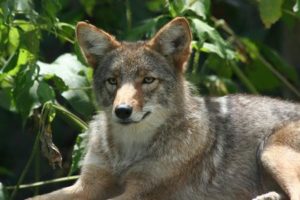Coyote Removal & Info
Resembling domesticated dogs, coyotes are carnivorous wild canines found throughout North America. Larger than foxes but smaller than wolves, they adapt well to a variety of environments, mostly due to humans encroaching on their habitat. Prevalent in grasslands, arid deserts, and even suburban environments, the coyote can be a nuisance. Additionally, the pest can be dangerous to humans and pets alike.
Biology & Behavior
The coyote and its relatives have been subjected to guns, traps, and poisons for many years and they continue to live in close proximity to humans. Coyotes can be very brave in their attempts to get food. Daylight raids are not uncommon; however, the usual suburban coyote moves under the cover of darkness, taking advantage of the situation. The chief food of coyotes includes rabbits, ground squirrels, gophers, meadow mice, deer and antelope fawns, fruits, insects, and livestock. Coyotes generally make their dens by enlarging an existing burrow by digging. An average litter consists of 6 pups born in the early spring. The most significant enemy of the coyote is the human.
Noises
What Does a Coyote Sound Like?
Rather than the soul-haunting, drawn-out sound of a wolf’s howl, a coyote’s howl is characterized by high-pitched barks and yips, with each song consisting of a lot of lyrics. And, coyote songs can be loud. Researchers have speculated that the intensity and volume of the vocalizations may also have meaning.
Tracks

Coyote footprints are oval-shaped and measure approximately 2.5 inches long by 2 inches wide. They register four toes with claws in both front and hind feet. Their tracks are relatively symmetrical, though they can show a slight lead toe/claw that allows left and right feet to be differentiated.
Scat
Coyote scat may be up to 4 inches long & 3/4 of an inch in diameter. Their scat may contain evidence of hair, bones, fruits & berries. … Their scat is blunt ended 3/4 to 1 inch in diameter. Deer scat is oval in shape, pellet like 1/2 to 5/8 inches in diameter, black in color scattered piles.
Damage
The coyote eats fruits, grasses, vegetables, insects, rodents, deer, and small mammals. In addition coyotes are also predators of domestic livestock, specifically sheep and goat, they present a danger to pets such as dogs and cats, and there are records of coyotes attacking small children.
Pictures
Commonly ASKED QUESTIONS?
What do you do with trapped animals?
That answer depends on the state in which you live. Each state has their own laws that dictate what we must do when it comes to controlling wildlife on your property. In some states, we can trap, transfer and release the animals. In some states we can trap the animals, but we can only release them back onto your own property. If you don’t want the animal released on your property, it must be humanely euthanized. Sometimes we don’t even need to trap the animal and a simple exclusion device (one-way door) can be installed to allow the animal to exit your home and be locked out.
How much does it cost to remove an animal?
There are a number of factors that determine pricing; location of the animal (i.e. – chimney, attic, crawl, wall void, living area), condition of the animal (i.e. – sick, aggressive, dead), location and condition of the property and time of year (i.e. – weather condition, offspring present?). Generally speaking, pricing will vary by location and species for just the animal removal and that pricing usually does not include the entry repair.
I think I have birds in my chimney, can you get them out?
The answer to that question is most likely “Yes”, but are you sure what you’re hearing is birds? Raccoons easily invade chimneys and they have their litters on the smoke shelf of fireplaces. The sounds baby raccoons make are often mistaken for birds in chimneys and removal can be difficult. The only birds that nest in chimneys are chimney swifts and they’re federally protected, so removal can’t be performed, but exclusion can be – once they depart. If you have a pre-fabricated chimney and birds fall between the cooling tubes, removal is nearly impossible.
How soon can you get here?
Office hours vary from franchise to franchise, but generally speaking, office hours are 8am – 6pm M-F and 9am – 3pm on Saturdays.
Clients Testimonials
OUR EXPERTS WILL SOLVE THEM IN NO TIME.
Have Any Pest Problems?
Navigations
Contact Information

At Critter Removers we're committed to providing you with the highest level of services and solutions to best fit your pest or critter control needs.

